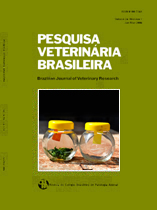 |
|
|
|
Year 2012 - Volume 32, Number 3
|

|
Cytology of tracheobronchial and bronchoalveolar lavage in healthy Holteins calves during the first month of life, 32(3):267-270
|
ABSTRACT.- Benesi F.J., Wachholz L., Bertagnon H.G., Leal M.L.R., Mori E. & Fernandes W.R. 2012. [Cytology of tracheobronchial and bronchoalveolar lavage in healthy Holteins calves during the first month of life.] Citologia dos lavados traqueobrônquico (LTB) e broncoalveolar (LBA) de bezerros holandeses sadios durante o primeiro mês de vida. Pesquisa Veterinária Brasileira 32(3):267-270. Departamento de Clínica Médica, Faculdade de Medicina Veterinária e Zootecnia, Universidade de São Paulo, Av. Prof. Dr. Orlando Marques de Paiva 87, São Paulo, SP 05508-270, Brazil. E-mail: febencli@usp.br
The neonatal calf is a critical moment for adaptation of the newborn to extra uterine life. The respiratory tract is functionally very demanded and often affected by disease, resulting in direct loss of their function and causing serious economic losses in livestock. The basic point to reduce these losses is appropriate clinical evaluation of neonates; but the diagnosis based solely in physical examination is very difficult to establish. The use of complementary analysis such cytology of the respiratory tract becomes an important diagnostic tool; however their findings must be standardized in the face of different techniques employed. This research studied the dynamics of the cellularity of the bronchoalveolar and tracheobronchial region obtained through lung lavage harvested by nasotracheal catheterization technique and tracheocenthesis respectively, during the first month of life of healthy calves. The tracheobronchial cytology was influenced by the time, showing decreased number of alveolar macrophages and greater number of neutrophils, possibly increased by local irritation caused by the technique, which was repeated sequentially, and/or through greater stimulation of inhaled microorganisms deposited in this region. In the bronchoalveolar region no variation in the cellular constituents in function of time was found. The results allowed the conclusion the cell population of the tracheobronchial region has changed over the week-old calves, possibly due to the technique used and/or to the normal region physiology, represented by higher magnitudes of neutrophils. Otherwise, the cells of the broncholaveolar region showed a stable behavior during the first month of life of newborn calves, presenting numerical predominance of alveolar macrophages. |
| |
|
|
| |
|
 |